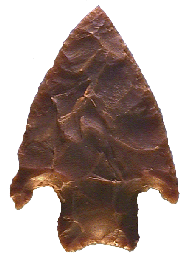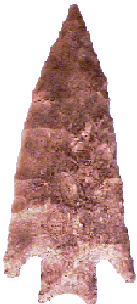



Point Type: MARSHALL
Also See: Castroville, Ensor,
Marcos, Pedernales
Location: Midwestern States
Associated Dates:
6000 - 2000 B.P. - Mid-Archaic to Woodland
Morphology: Basal
Notched / Corner
Notched
General Description: The Marshall is a medium to large sized triangular bladed, broad, corner notched to basal notched point with strong shoulders and long barbs that often turn inward towards the base. The stem is relatively short in relation to the blade length and can be straight to slightly expanding and can have what appear to be auricles on some specimens. The basal edge is usually concave and occasionally straight or convex but never rounded. The barbs can be clipped and tend to be drooping on some specimens. Additionally, the notching can be asymmetrical on some examples. The blade edges are usually convex but may appear to be either straight or rarely concave depending on the amount of rework that has been performed on the blade. The general outline of the blade is very triangular but can appear to be oval on unsharpened specimens that have not been reworked. Dimensions, length and shape vary greatly with the Marshall point however the typical Marshall ranges in size from 51 mm to 115 mm in length. The type is thin and well made usually with high quality flaking. The base is typically ground and thinned.
The Marshall appears to be an early type of blade form and it is commonly associated with the Archaic period. The Marshall is commonly found with Pedernales points. The point is found in Texas eastern Oklahoma and western Arkansas. It should be noted that the Marshall when in worn out and discard form can be very hard to differentiate from worn out Castroville points as they look alike.
The point was named the "Marshall Barbed" by D.A. Suhm, A.D. Krieger and E.B. Jelks from specimens found in 1954 near the Marshall Ford Reservoir near the town of Marshall Ford, Travis County, Texas. In the past, the type has been called the "Smithwick Small Stem" and "Bluffton Barbed".
About the Point Above (Left): The point pictured at the top left of this page was found in Fire Creek Gillespie Coutny Texas and was formerly in the Pat Dunnegan collection. It is made from a dark brown chert that is quite glossy. It measures 67 mm in length, 43 mm wide at the shoulder barbs, and is 8 mm at its thickest point (at the barbs in mid blade). The blade which has excurvate edges is a uniform 3.5 mm in thickness. The blade edges still retain much sharpness. The stem is 17 mm long, 21 mm wide and the concavity of the base is 2 mm deep. The base of the stem and the stem sides have been slightly ground and thinned. Catalog Number 7-85-U
About the Point Above (Right): The point pictured at the top right of this page, is from the town of Bee Cave in Travis County, Texas. It is made from a dull, dirty, mottled, tanish colored chert that is quite granular and has buff colored inclusions. The point is highly patinated and is well coated with callche. It measures 79 mm in length, 33 mm wide at the shoulder barbs, and is only 6.5 mm at its thickest point (at the barbs in mid blade). The blade which has slightly excurvate edges is a uniform 4.5 mm in thickness. The blade edges are still quite sharp. The stem is 13 mm long, 15.5 mm wide and the concavity of the base is 3 mm deep. The base of the stem and the stem sides have been slightly ground. Although this blade has some aspects of the Pedernales type, I have placed it here in the Marshall type as it shares more Marshall traits than Pederenales traits, especially the long barbs, and small base. Catalog Number 8-100-C
References: Bell (1), Davis, Justice, Overstreet, Perino (1), Turner & Hester
© Copyright 1997 - 2008 LITHICS-Net WWW.LITHICSNET.COM
Use Your Browser's BACK Button to Return to the LITHICS-Net Index.